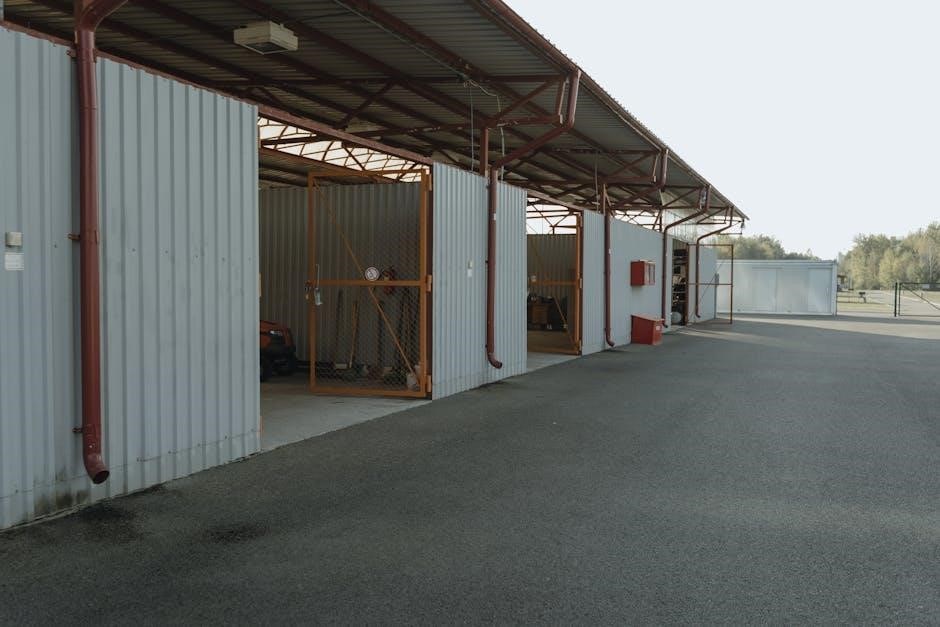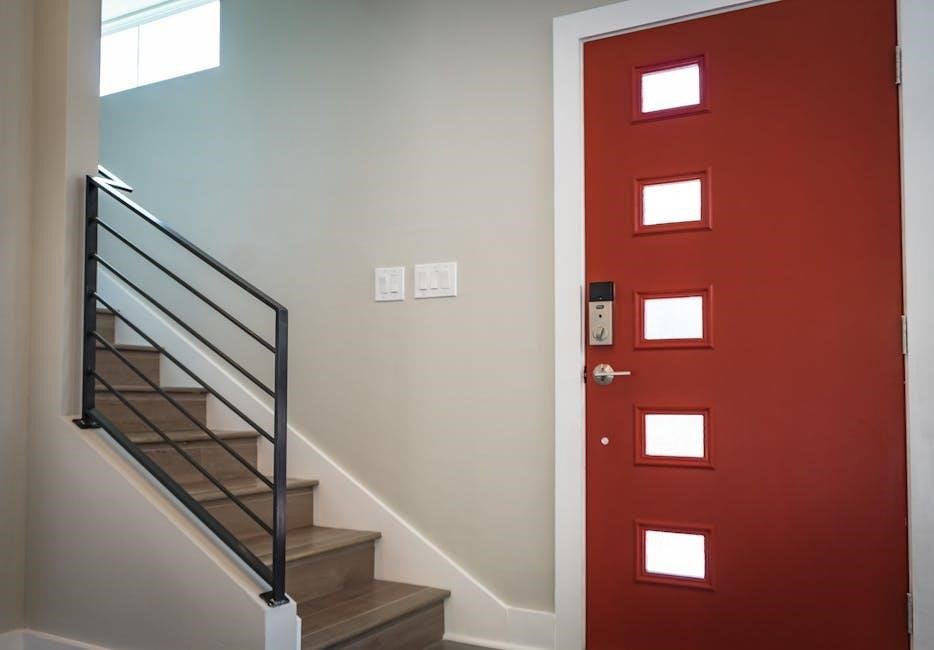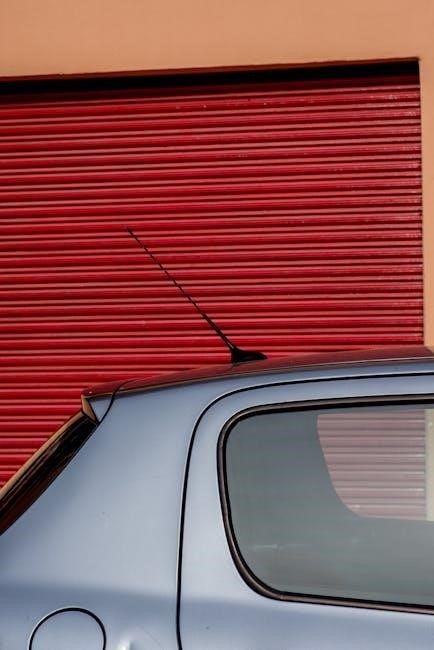A manual garage door that won’t open can be frustrating, often caused by issues like locked mechanisms, broken springs, or misaligned tracks. This guide helps you identify and resolve the problem efficiently.
1.1. Understanding the Issue
A garage door that won’t open manually can stem from various issues, such as a locked mechanism, broken springs, or misaligned tracks. Identifying the root cause is crucial for effective resolution. Common problems include insufficient lubrication, worn-out rollers, or a faulty emergency release. Understanding these factors helps in applying the right fixes, whether through simple DIY solutions or professional intervention. This section breaks down the key elements to help you diagnose and address the issue efficiently, ensuring your garage door functions smoothly once again.
1.2. Importance of Addressing the Problem
A garage door that won’t open manually poses significant safety risks and inconveniences. Broken springs or damaged components can lead to accidents, while neglecting the issue may result in further damage, increasing repair costs. Additionally, a malfunctioning door can compromise security and energy efficiency, allowing cold air or moisture to enter. Addressing the problem promptly ensures safety, maintains property value, and prevents minor issues from escalating into costly repairs. Regular maintenance and timely fixes are essential for smooth operation and peace of mind.

Common Causes of a Garage Door That Won’t Open Manually
A garage door may fail to open manually due to a locked mechanism, broken springs, misaligned tracks, insufficient lubrication, or a faulty emergency release system.
2.1. The Door is Locked
One of the most common reasons a garage door won’t open manually is that it is locked. Many garage doors come equipped with a manual locking mechanism, which can be engaged accidentally or intentionally for security purposes. If the door is locked, it will not budge, even if you try to lift it or use the opener. To resolve this, you’ll need to locate the locking mechanism, usually found near the center of the door or on the side, and disengage it. This is often done by sliding a latch or turning a handle. Always ensure the door is fully unlocked before attempting to open it manually, as forcing it could cause damage to the door or its components.
2.2. Broken or Worn-Out Torsion Springs
Broken or worn-out torsion springs are a common cause of a garage door that won’t open manually. These springs are under extreme tension and play a crucial role in counterbalancing the door’s weight. If a spring breaks, the door becomes too heavy to lift, even manually. Attempting to close or open the door with a broken spring can lead to further damage or injury. Signs of worn-out springs include loud noises, uneven door movement, or visible gaps in the spring coils. Always handle spring repairs with caution, as the high tension can be dangerous. If you suspect a spring issue, it’s best to call a professional to avoid potential risks.
2.3. Misaligned or Blocked Tracks
Misaligned or blocked tracks are a common issue preventing manual garage door operation; Signs include gaps between rollers and rails, misshapen elements, or unusual noises during movement. Clearing debris and ensuring tracks are aligned properly can often resolve the problem. However, forcing the door open can exacerbate damage, leading to costly repairs. Regular inspections and timely maintenance are essential to maintain smooth functionality and prevent potential hazards.
2.4. Insufficient Lubrication
Insufficient lubrication of moving parts is a common cause of a garage door that won’t open manually. Hinges, rollers, and springs require regular lubrication to function smoothly. Without it, friction increases, making the door difficult to open. Over time, this can lead to premature wear or even mechanical failure. Proper lubrication ensures smoother operation and reduces the risk of further damage. Always use a suitable lubricant for garage door components to maintain their longevity and performance. Regular maintenance can prevent this issue from arising.
2.5. Faulty or Disconnected Emergency Release
A faulty or disconnected emergency release mechanism can prevent your garage door from opening manually. The emergency release is designed to disengage the opener, allowing manual operation. If the release handle is damaged or not properly connected, it can block the door’s movement. This issue often occurs due to accidental disengagement or wear over time. Check the release handle and ensure it is fully engaged. If the problem persists, inspect the connection points for damage or misalignment. Addressing this issue promptly can restore manual functionality and avoid further complications.

Troubleshooting Steps
Start by checking the power source, remote batteries, and manual lock status. Inspect springs, cables, and tracks for damage or misalignment to identify the root cause efficiently.
3.1. Checking the Power Source
Begin by verifying the garage door opener’s power supply. Ensure the unit is properly plugged into a functioning electrical outlet. Check the circuit breaker or fuse box to confirm the garage door circuit hasn’t tripped or blown a fuse. If the opener is unplugged or the power is out, it won’t operate, even manually. Additionally, inspect the wiring for any visible damage or disconnections. A loss of power can prevent the opener from engaging, making manual operation difficult or impossible. This simple check can often resolve the issue quickly.
3.2. Inspecting the Remote Control Batteries
Dead or weak batteries in your remote control can prevent the garage door from opening. Replace the batteries with new ones, ensuring they are the correct type and properly installed. Test the remote afterward to see if it functions. If issues persist, check for physical obstructions between the remote and the opener or ensure the remote is correctly programmed. Weak signals or misalignment can also affect performance. This step is crucial for diagnosing remote-related problems before exploring other potential causes.
3.3. Verifying the Manual Lock Status
One common reason a garage door won’t open manually is that it may be locked. Check for a manual lock mechanism, often located on the inside of the door. If the lock is engaged, it will prevent the door from opening. To resolve this, disengage the lock by sliding the latch or turning the handle. If the door is locked from the inside and you don’t have access, you may need to enter through a side door or use a key to unlock it. Always ensure the lock is fully disengaged before attempting to open the door manually.
3.4. Assessing the Condition of Springs and Cables
Inspect the torsion springs above the door for signs of damage, such as gaps or sagging. Broken or worn-out springs can make the door impossible to open manually. Similarly, frayed or snapped cables can disrupt the door’s balance, causing it to malfunction. If you notice any issues with the springs or cables, avoid attempting DIY repairs due to the high tension they hold, which can lead to injury. Instead, consult a professional to ensure safe and proper replacement or adjustment of these critical components.
3.5. Ensuring the Tracks are Clear and Aligned
Check the garage door tracks for debris, dirt, or obstructions that could block movement. Misaligned tracks can prevent the door from opening smoothly. Inspect both vertical and horizontal sections for proper alignment. If the tracks are uneven, gently bend them back into place using a wrench or pliers. Ensure all bolts securing the tracks to the wall or ceiling are tightened firmly. Clean the tracks regularly to remove dust and grease buildup, which can hinder door operation. Properly aligned and clear tracks are essential for smooth manual opening and closing of the garage door.

Safety Precautions
Always handle garage door springs with caution due to their high tension, which can cause severe injury. Avoid DIY repairs for complex issues and ensure proper ventilation during maintenance to prevent accidents and health risks.
4.1. Understanding Spring Tension Risks
The torsion springs in your garage door are under extreme tension, making them dangerous to handle. If a spring breaks or unravels, it can cause serious injury or damage. Always wear protective gear and avoid attempting repairs without proper tools or expertise. Never touch or manipulate springs without understanding their tension risks, as this can lead to accidents. If you suspect a spring issue, it’s best to call a professional to ensure your safety and prevent further damage to the door system.
4.2. Avoiding DIY Repairs for Complex Issues
While minor fixes can be handled with DIY solutions, complex problems like broken torsion springs or misaligned tracks require professional attention. Incorrect DIY repairs can lead to further damage or safety hazards. Garage doors involve high-tension components that, if mishandled, can cause severe injuries. Additionally, improper repairs may void warranties or compromise the door’s structural integrity. For intricate issues, consulting a certified technician ensures safety and prevents potential long-term damage to your garage door system.
4.3. Ensuring Proper Ventilation During Repairs
Proper ventilation is crucial when repairing a garage door, especially if you’re using lubricants, cleaning products, or power tools. Open windows and doors to allow fresh air to circulate, reducing the risk of inhaling harmful fumes. Use fans to improve airflow and avoid working in a confined space. This ensures a safer environment and prevents dizziness or respiratory issues. Always prioritize ventilation to maintain a healthy and safe working condition while addressing garage door issues.

DIY Repair Solutions
Addressing a stuck garage door manually involves lubricating moving parts, realigning tracks, and replacing worn-out rollers. These simple fixes can restore smooth operation quickly and effectively.
5.1. Lubricating Moving Parts
Lubricating moving parts is essential for smooth garage door operation. Apply a silicone-based spray to hinges, rollers, and tracks. Avoid grease, as it attracts dust. Spray lightly, then wipe excess with a cloth. This reduces friction and wear, ensuring the door opens effortlessly. Regular lubrication prevents stiffness and corrosion, keeping the door functional. Always test the door after lubrication to ensure proper movement. Addressing this simple fix can resolve many manual operation issues quickly and effectively.
5.2. Realigning the Tracks
To realign the garage door tracks, start by inspecting them for any bends or misalignments. Use a wrench or screwdriver to adjust the bolts securing the tracks to the wall. Ensure the tracks are straight and parallel, using a level to verify proper alignment. Loosen the bolts, carefully shift the tracks into the correct position, and tighten them firmly. Avoid over-tightening, which could warp the tracks. After realignment, test the door by opening and closing it manually to ensure smooth movement. If issues persist, consider additional lubrication or inspecting other components like springs or cables.
5.3. Replacing Worn-Out Rollers
Worn-out rollers can cause a garage door to malfunction and refuse to open manually. Inspect the rollers for signs of wear, such as rust, dents, or uneven movement. To replace them, start by disconnecting the door from the opener and carefully lifting it to relieve tension. Remove the old rollers by taking out the bolts securing them to the door or track. Install new rollers, ensuring they are properly aligned and securely fastened. Lubricate the rollers to ensure smooth operation. Test the door by opening and closing it manually to confirm the issue is resolved.
When to Call a Professional
If your garage door has broken springs, severe damage, or complex mechanical issues, it’s best to call a professional for safe and effective repairs.
6.1. Identifying Signs of Severe Damage
Severe damage to a garage door can manifest in several ways. Look for visible breaks or stretching in torsion springs, as these indicate a critical failure. If the door sags unevenly or refuses to align properly, it may signal structural issues. Unusual noises, such as grinding or scraping sounds, can point to worn or damaged rollers or tracks. Additionally, frayed or snapped cables are a clear sign of severe damage, as they compromise the door’s stability and safety. These issues require immediate professional attention to prevent further harm or accidents.
6.2. Handling Broken Springs or Cables
Broken torsion springs or cables are critical issues that require immediate attention. These components are under extreme tension and can cause severe injury if mishandled. If you notice a snapped spring or frayed cable, avoid attempting DIY repairs, as this can escalate the problem. Instead, contact a professional technician who has the tools and expertise to safely replace or repair these parts. Never operate the door manually or with an opener if springs or cables are compromised, as this could lead to further damage or accidents. Professional intervention is essential to ensure your safety and restore proper door function.
6.3. Addressing Complex Mechanical Issues
Complex mechanical problems, such as misaligned tracks or broken springs, often require professional expertise. Attempting DIY repairs for these issues can lead to further damage or safety risks. If the door’s system is compromised, a professional can assess the situation and implement the necessary fixes. They will have the tools and knowledge to realign tracks, replace springs, or repair cables safely and effectively. Don’t risk personal injury or additional damage—call a qualified technician to handle intricate mechanical problems and ensure the door operates smoothly and securely.
Preventative Maintenance Tips
Regular lubrication of moving parts, inspecting springs and cables, and cleaning tracks can prevent manual garage door issues. These simple steps ensure smooth operation and extend longevity.
7.1. Regular Lubrication of Moving Parts
Regular lubrication is essential for maintaining smooth garage door operation. Apply a silicone-based lubricant to hinges, rollers, and springs every 6-12 months. This prevents metal-on-metal friction and reduces wear. Avoid using WD-40, as it attracts dust and dirt. Lubricate moving parts like pulleys and cables to ensure seamless movement. Neglecting this can lead to increased strain on springs and motors. Always wear gloves for safety and wipe off excess lubricant with a cloth. Proper lubrication keeps your garage door running quietly and efficiently, extending its lifespan.
7.2. Inspecting Springs and Cables
Regularly inspecting garage door springs and cables is crucial for safe operation. Look for signs of wear, rust, or fraying on cables. Check torsion springs for gaps between coils, which indicate wear. If a spring is stretched or broken, the door may not open manually. Inspect extension springs for sagging or separation. Damaged springs or cables require immediate attention to prevent accidents. Use protective gloves and safety goggles during inspections. Replace any damaged components promptly to ensure smooth, safe door operation. Always consider consulting a professional if unsure. Regular checks prevent unexpected failures and enhance safety.
7.3. Cleaning and Aligning Tracks
Clean and align garage door tracks regularly to ensure smooth operation. Use a cloth and mild solvent to remove dirt, grease, or debris that may obstruct movement. Check for misalignment by inspecting the tracks with a level. If uneven, loosen the mounting bolts and adjust the tracks to ensure proper alignment. Tighten the bolts securely after adjustments. Misaligned tracks can cause the door to bind or stick; Regular cleaning and alignment prevent manual operation difficulties and extend the lifespan of your garage door system. Always test the door after adjustments to ensure smooth functionality. Neglecting track maintenance can lead to more severe issues over time. Avoid using harsh chemicals that may damage the tracks. Properly aligned tracks ensure the rollers move freely, reducing strain on springs and cables. Regularly lubricate the tracks as part of your maintenance routine. This simple step can prevent many common problems and keep your garage door operating effortlessly. If tracks are severely damaged or bent, consider replacing them to maintain safety and functionality. Always prioritize track maintenance to avoid unexpected door malfunctions. Cleaning and aligning tracks is a straightforward process that requires minimal tools but yields significant benefits for your garage door’s performance. By addressing track issues promptly, you can prevent more complex and costly repairs down the line. Regular maintenance ensures your garage door remains reliable and easy to open manually. Always inspect tracks after extreme weather conditions or heavy use, as debris or shifts may affect alignment. Properly maintained tracks are essential for the overall health of your garage door system. Cleaning and aligning tracks is a simple yet effective way to ensure smooth, trouble-free operation. Don’t overlook this critical step in your garage door maintenance routine. Clean tracks and proper alignment are key to preventing manual operation issues. Addressing track problems early saves time and money in the long run. Keep your garage door running smoothly by prioritizing track cleaning and alignment. This simple maintenance task can prevent a wide range of issues and ensure your door opens effortlessly every time. Regularly cleaning and aligning tracks is an essential part of garage door upkeep. By staying on top of track maintenance, you can avoid many common problems and extend the life of your garage door system. Clean and aligned tracks are vital for smooth manual operation. Don’t let neglected tracks lead to costly repairs—address them today. Proper track maintenance is a small effort that makes a big difference in your garage door’s functionality. Clean and align your tracks regularly to enjoy a hassle-free garage door experience. Regular track cleaning and alignment are simple steps that can prevent major issues and keep your garage door operating smoothly. Maintain your garage door’s performance by prioritizing track care. Clean and aligned tracks ensure your door opens manually without difficulty. Regular maintenance is key to preventing track-related problems. Keep your garage door in top condition by cleaning and aligning the tracks regularly. Proper track maintenance is essential for smooth operation. Don’t let track issues disrupt your daily routine—address them with regular cleaning and alignment. Clean and aligned tracks are crucial for a well-functioning garage door. Regular maintenance ensures your door opens manually without hassle. Keep your garage door running smoothly by cleaning and aligning the tracks today. Regular track maintenance is vital for preventing manual operation issues. Clean and aligned tracks ensure your garage door operates effortlessly. Don’t neglect track care—address it regularly to avoid costly repairs. Properly maintained tracks are essential for a reliable garage door. Clean and align your tracks to ensure smooth manual operation. Regular maintenance prevents track-related problems and extends the life of your garage door. Keep your garage door in great condition by cleaning and aligning the tracks regularly. Clean tracks and proper alignment are key to preventing manual operation difficulties. Regular maintenance ensures your garage door operates smoothly. Don’t let track issues cause problems—clean and align them today. Proper track maintenance is essential for a well-functioning garage door. Clean and aligned tracks ensure smooth manual operation. Regular care prevents costly repairs and keeps your door running effortlessly. Keep your garage door in top shape by cleaning and aligning the tracks regularly. Regular maintenance ensures smooth operation and prevents track-related issues. Clean and aligned tracks are vital for a reliable garage door. Don’t overlook track care—address it regularly to maintain functionality. Properly maintained tracks ensure your garage door opens manually without difficulty. Regular cleaning and alignment are simple steps that make a big difference. Keep your garage door running smoothly by prioritizing track maintenance. Clean and aligned tracks are essential for smooth manual operation. Regular care prevents problems and extends the life of your garage door. Maintain your garage door’s performance by cleaning and aligning the tracks regularly. Proper track maintenance is crucial for preventing manual operation issues. Clean and aligned tracks ensure your door operates effortlessly. Don’t let track neglect lead to costly repairs—address them today. Regular track cleaning and alignment are vital for a well-functioning garage door. Keep your door running smoothly by prioritizing track care. Clean and aligned tracks ensure manual operation is easy and hassle-free. Regular maintenance prevents track-related problems and keeps your garage door in great condition. Don’t let track issues disrupt your routine—clean and align them regularly; Properly maintained tracks are essential for a reliable garage door. Clean and aligned tracks ensure smooth manual operation. Regular maintenance is key to preventing costly repairs and ensuring your door runs smoothly. Keep your garage door in top condition by cleaning and aligning the tracks today. Regular track maintenance is crucial for preventing manual operation difficulties. Clean and aligned tracks ensure your door operates effortlessly. Don’t neglect track care—address it regularly to maintain functionality. Properly maintained tracks are vital for a well-functioning garage door. Clean and aligned tracks ensure smooth manual operation. Regular cleaning and alignment prevent track-related issues and extend the life of your door. Keep your garage door running smoothly by prioritizing track maintenance. Clean and aligned tracks are essential for hassle-free manual operation. Regular care prevents problems and ensures your door opens effortlessly. Don’t let track neglect lead to costly repairs—address them with regular cleaning and alignment. Proper track maintenance is key to a reliable garage door. Clean and aligned tracks ensure smooth manual operation. Regular maintenance prevents issues and keeps your door in great condition. Keep your garage door running smoothly by cleaning and aligning the tracks regularly. Clean tracks and proper alignment are vital for preventing manual operation problems. Regular maintenance ensures your door operates effortlessly. Don’t overlook track care—address it regularly to avoid disruptions. Properly maintained tracks ensure smooth garage door operation. Clean and aligned tracks are essential for manual functionality. Regular maintenance prevents track-related issues and extends the life of your door. Keep your garage door in top shape by prioritizing track care. Clean and aligned tracks ensure smooth manual operation. Regular cleaning and alignment are simple steps that make a big difference. Don’t let track neglect cause problems—address them today. Proper track maintenance is crucial for a well-functioning garage door. Clean and aligned tracks ensure your door opens manually without difficulty. Regular care prevents costly repairs and keeps your door running smoothly. Maintain your garage door’s performance by cleaning and aligning the tracks regularly. Proper track maintenance is essential for smooth manual operation. Clean and aligned tracks prevent track-related issues and ensure effortless functionality. Regular cleaning and alignment are vital for a reliable garage door. Keep your door in great condition by prioritizing track care. Clean and aligned tracks ensure smooth operation and prevent manual difficulties. Regular maintenance is key to avoiding costly repairs. Don’t let track issues disrupt your routine—clean and align them today. Properly maintained tracks are essential for a well-functioning garage door. Clean and aligned tracks ensure smooth manual operation. Regular care prevents problems and extends the life of your door. Keep your garage door running smoothly by cleaning and aligning the tracks regularly. Clean tracks and proper alignment are crucial for preventing manual operation issues. Regular maintenance ensures your door operates effortlessly. Don’t neglect track care—address it regularly to maintain functionality. Properly maintained tracks ensure smooth garage door operation. Clean and aligned tracks are vital for manual functionality. Regular maintenance prevents track-related problems and keeps your door in great condition. Keep your garage door in top shape by prioritizing track care. Clean and aligned tracks ensure smooth manual operation. Regular cleaning and alignment are simple steps that make a big difference. Don’t let track neglect cause problems—address them today. Proper track maintenance is essential for a well-functioning garage door. Clean and aligned tracks ensure your door opens manually without difficulty. Regular care prevents costly repairs and keeps your door running smoothly. Maintain your garage door’s performance by cleaning and aligning the tracks regularly. Proper track maintenance is crucial for smooth manual operation. Clean and aligned tracks prevent track-related issues and ensure effortless functionality. Regular
A garage door that won’t open manually can be a significant inconvenience, but with proper troubleshooting and maintenance, most issues can be resolved. Regular lubrication, inspecting springs and tracks, and addressing alignment problems are key to preventing difficulties. While some fixes are simple, others may require professional expertise, especially when dealing with broken springs or complex mechanical failures. By following the tips outlined in this guide, you can ensure your garage door operates smoothly and safely. Remember, consistent maintenance is essential to avoiding future problems and extending the lifespan of your garage door system.
